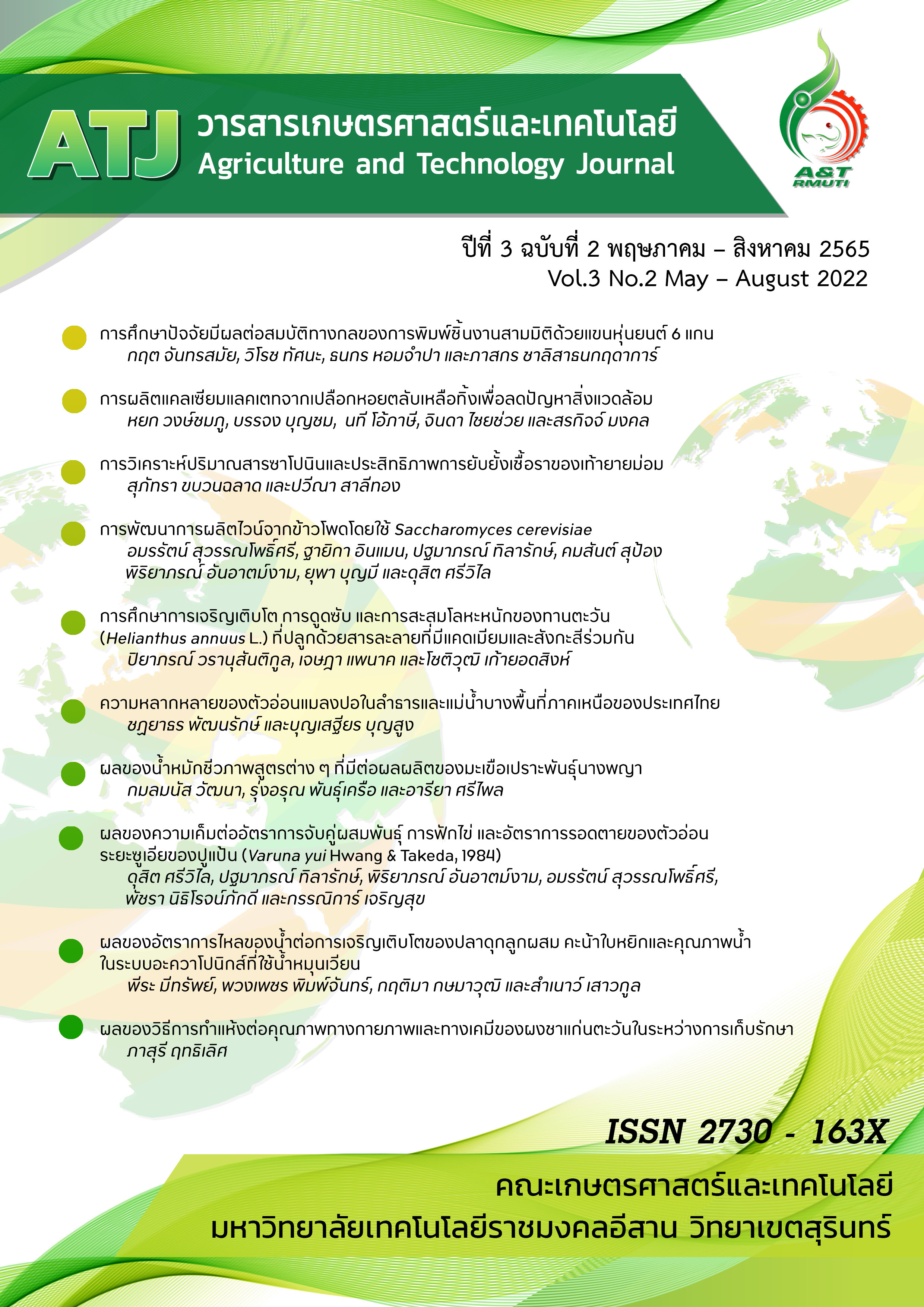ผลของอัตราการไหลของน้ำต่อการเจริญเติบโตของปลาดุกลูกผสม คะน้าใบหยิก และคุณภาพน้ำในระบบอะควาโปนิกส์ที่ใช้น้ำหมุนเวียน
Effect of water flow rates on growth of hybrid catfish (Clarias macrocephalus x C. gariepinus ), Curl leaf kale (Brassica oleracea var. acephala) and water quality parameters in aquaponic recirculating system
คำสำคัญ:
ระบบอะควาโปนิกส์, ผักคะน้าใบหยิก, ปลาดุกลูกผสมลูกผสม, อัตราการไหล, การกำจัดสารอาหารบทคัดย่อ
การศึกษาอัตราการไหลของน้ำในระบบอะควาโปนิกส์ที่มีผลต่อการเจริญเติบโตของปลาปลาดุกลูกผสม และคะน้าใบหยิก (Brassica oleracea Acephala) คุณภาพน้ำ และประสิทธิภาพในการกำจัดสารอาหารที่มีอยู่ในน้ำ อัตราการไหลที่แตกต่างกัน 3 ระดับ คือ 2,000 (T1), 2,400 (T2) และ 2,700 (T3) ลิตรต่อชั่วโมง วางแผนการทดลองแบบสุ่มสมบูรณ์ แต่ละทรีตเม้นต์มี 3 ซ้ำ ระบบการเลี้ยงปลาใช้ถังขนาด 1,000 ลิตร ปลาดุกลูกผสมมีน้ำหนักเฉลี่ยเริ่มต้น 100 กรัม อัตราการปล่อย 100 ตัวต่อตารางเมตร ผักคะน้าใบหยิก ซึ่งเพาะเลี้ยงต้นกล้าแล้วจึงย้ายลงรางปลูกในระบบอะควาโปนิกส์ มีขนาดราง 1×5×0.20 เมตร3 จำนวน 50 ต้นต่อชุด ประเมินอัตราการเจริญเติบโต ผลผลิตของปลา พืช และคุณภาพของน้ำ เมื่อสิ้นสุดระยะเวลาการทดลอง 90 วัน พบว่าอัตราการเจริญเติบโตของปลา มีความแตกต่างกันอย่างมีนัยสำคัญทางสถิติ (p<0.05) โดยมีค่าสูงขึ้นตามอัตราการไหลของน้ำที่เพิ่มขึ้น น้ำหนักเฉลี่ยมีค่าสูงที่สุดที่ T3 (276.54±2.14 กรัม) โดยค่าเฉลี่ยในกลุ่ม T2 และ T1 เท่ากับ 247.11±1.91 กรัม และ 200.50±1.05 กรัม อัตรารอดสูงสุดในกลุ่ม T3 (99.67±0.58 เปอร์เซ็นต์) รองลงมาคือ T2 (86.00±2.00 เปอร์เซ็นต์) และ ต่ำสุดใน T1 (80.33±1.52เปอร์เซ็นต์) ผลผลิตปลาสุทธิ (กิโลกรัมต่อลูกบาศก์เมตร) มีค่าสูงสุดคือ T3 (27.56±0.37) รองลงมาคือ T2 (21.25±0.38) และต่ำสุดใน T1 (17.71±0.31) ผลผลิตของผักคะน้าใบหยิกมีความแตกต่างกันอย่างมีนัยสำคัญทางสถิติ ผลผลิตในรูปน้ำหนักสดสูงสุดที่พบ คือ T1 (185.81±3.90 กิโลกรัม) ตามด้วย T2 (185.81±3.90 กิโลกรัม) และ T3 (130.50±4.16 กิโลกรัม) โดยน้ำหนักแห้งมีค่าลดลงในลักษณะที่สอดคล้องกัน ระบบอะควาโปนิกส์สามารถลดปริมาณมลพิษของน้ำจากการเลี้ยงปลาได้อย่างมีนัยสำคัญ โดยมีประสิทธิภาพในการลดปริมาณของ BOD5, TSS, TAN, NO2-N, NO3-N และ TP อยู่ในช่วงต่างๆ ดังต่อไปนี้ 44.88–53.51, 65.04-67.15, 2.25–85.60, 65.51-77.19, 65.82-74.77 และ 53.68–54.72 เปอร์เซ็นต์ ตามลำดับ ประสิทธิภาพในการบำบัดมลพิษที่ดีที่สุดที่อัตราการไหลสูงที่สุดคือ 2,700 ลิตรต่อชั่วโมง
เอกสารอ้างอิง
ดำรงค์ โลหะลักษณาเดช, กฤษฎา พราหมณ์ชูเอม, วิกิจ ผินรับ และ ณิศา มาซู. (2555). การเลี้ยงปลานิลร่วมกับการปลูกผักโดยไม่ใช้ดินแบบ DYNAMIC ROOT FLOATING TECHNIQUE. น.447-454 ใน เรื่องเต็มการประชุมทางวิชาการของมหาวิทยาลัยเกษตรศาสตร์ ครั้งที่ 50: สาขาสัตว์, สาขาสัตวแพทยศาสตร์, สาขาประมง. กรุงเทพฯ.
ธีระรัตน์ ชิณแสน, นภาพร เวชกามา, จักรกฤษณ์ วรรณวิชิต, เมวิกา อันทะลัย, อภิชาติ ออมอด และ เกศศิรินทร์ แสงมณี. (2560). ผลของการใช้น้ำเหลือทิ้งจากการเลี้ยงปลาดุกต่อการเจริญเติบโตและผลผลิตของผักกวางตุ้งฮ่องเต้ในระบบการปลูกพืชโดยไม่ใช้ดินแบบสารละลายธาตุอาหารไม่หมุนเวียน. วารสารเกษตรพระวรุณ. 14(1): 71-81.
อุธร ฤทธิ์ลึก, สรรลาก สงวนดีกุล และศรัณยา รักเสรี. (2556ก). การวิจัยพัฒนาระบบอะควาโปนิคสำหรับบำบัดน้ำเสียในระบบเลี้ยงปลาดุกลูกผสมแบบใช้น้ำหมุนเวียน. วารสารวิจัย. 6(1): 103-112.
อุธร ฤทธิ์ลึก, สรรลาก สงวนดีกุล และศรัณยา รักเสรี. (2557b). ผลของความหนาแน่นต่อสมรรถภาพการเจริญเติบโตและผลผลิตของปลาดุกในบ่อคอนกรีตที่ใช้น้ำเสียจากบ่อเลี้ยงปลานิลระบบอะควาโปนิสก์. วารสารวิจัย. 7(2): 77-86.
ปฐมพงษ์ กาศสกุล, ประจวบ ฉายบุ, ชนกันต์ จิตมนัส และเกรียงศักด์ เม่งอำพัน. (2557). ความหนาแน่นที่เหมาะสมของการเลี้ยงปลานิลในระบบน้ำหมุนเวียนแบบอะควาโปนิกส์. วารสารวิจัยเทคโนโลยีการประมง. 8(1): 23-32.
วีระยุทธ เลื่อนลอย, พ้วน เพ่งเซ้ง, ปิยะพงศ์ โชติพันธุ์ และสมศักดิ์ มณีพงศ์. (2557). ผลของอัตราส่วนพื้นที่ปลูกและปริมาตรน้ำต่อผลผลิตผักบุ้งจีน ปลานิลและคุณภาพน้ำในระบบปลูกพืชร่วมกับการเลี้ยงปลา. วารสารวิจัยเทคโนโลยีการประมง 8(2): 10-19.
สุฤทธิ์ สมบูรณ์ชัย, ประจวบ ฉายบุ, เกรียงศักดิ์ เม่งอําพัน และอานัฐ ตันโช. (2551). การศึกษาวัสดุกรองทางชีวภาพ เพื่อใช้ในระบบการเลี้ยงปลาดุกลูกผสมร่วมกับระบบการปลูกพืชแบบไฮโดรโพนิคส์. วารสารวิจัยเทคโนโลยีการประมง. 2(1): 55-65.
APHA. (2005). Standards methods for the examination of water and wastewater. 21st Edition. APHA, Washington DC, USA.
Afolabi K.A. (2020). Productivity of Kale (Brassica oleracea var. acephala) and Nile tilapia (Oreochromis niloticus) Culture in Aquaponic Systems. M.Sc. Thesis. The American University in Cairo, AUC Knowledge Fountain.
Arthanawa I.G.N., Astiko I.N. Yana D.P.S. and Darmawan I.K. (2021). Utilization of biofloc system catfish pond Waste nutrients in the cultivation of Kale, Spinach, Pakcoy, and Lettuce Using the Aquaponic. System. Sustainable Environment Agricultural Science (SSEA). 5(1): 66-71.
Ayaz F.A., Glew R.H., Millson M., Huang H.S., Chuang L.T., Sanz C. and Hayırlıoglu-Ayaz S. (2006). Nutrient contents of kale (Brassica oleraceae L. var. acephala DC.). Food chemistry. 96(4): 572-579.
Bregnballe J. (2015). A Guide to Recirculation Aquaculture. An introduction to the new environmentally friendly and highly productive closed fish farming systems. Published by the Food and Agriculture Organization of the United Nations (FAO) and EUROFISH International Organization.
Cartea M.E., Velasco P., Obregón S., Padilla G. and De Haro A. (2008). Seasonal Variation in Glucosinolate Content in Brassica oleracea Crops Grown in Northwestern Spain. Phytochemistry. 69(2): 403-410.
Chung M.J., Lee S.H. and Sung N.J. 2002. Inhibitory effect of whole strawberries, garlic juice or kale juice on endogenous formation of N-nitrosodimethylamine in humans. Cancer Letters. 182(1): 1-10.
Diver S. (2006). Aquaponics-integration of hydroponics with aquaculture. Publication no. IP163. ATTRA, National Sustainable Agriculture Information Service.
Dushenkov V., Kumar PBAN., Motto H. and Raskin L. (1995). Rhizofiltration: the use of plants to remove heavy metals from aqueous streams. Environ Sci Technol. 19: 1239–1245.
Enduta A., Jusoh A., Ali N., Wan Nik W.N.S. and Hassan A. (2009). Effect of flow rate on water quality parameters and plant growth of water spinach (Ipomoea aquatica) in an aquaponic recirculating system. Desalination and Water Treatment. 5: 19–28.
Ghaly A.E., Kamal M. and Mahmoud N.S. (2005). Phytoremediation of aquaculture wastewater for water recycling and production of fish feed. Environment International. 31(1): 1-13.
Hussain T., Verma A. K., Tiwari V. K., Prakash C., Rathore G., Shete A. P. and Saharan N. (2014). Effect of water flow rates on growth of Cyprinus carpio var. koi (Cyprinus carpio L., 1758) and spinach plant in aquaponic system.
Khachik F., Beecher G.R. and Goli M.B. (1991). Separation, identification, and quantification of carotenoids in fruits, vegetables and human plasma by high performance liquid chromatography. Pure and Appl. Chem. 63(1): 71-80.
Kahlon T.S., Chapman M.H. and Smith G.E. (2007) In vitro binding of bile acids by spinach, kale, brussels sprouts, broccoli, mustard greens, green bell pepper, cabbage and collards. Food Chemistry. 100(4): 1531-1536.
Kim S.Y., Yoon S., Kwon S.M., Park K.S. and Lee-Kim Y.C. (2008). Kale juice improves coronary artery disease risk factors in hypercholesterolemic men. Biomedical and Environmental Sciences. 21(2): 91-97.
Kural B.V., Kucuk N., Balaban Y. and Orem A. (2011). Effects of kale (Brassica oleracea) leave extracts on the susceptibility of very low and low density lipoproteins to oxidation. Indian Journal. of Biochemistry. and Biophysics. 2: 361-364.
Lewis W.M., Yopp J.H., Schramm H.L. and Brandenburg A.M. (1978). Use of hydroponics to maintain quality of recirculated water in a fish culture system. Transactions of the American Fisheries Society. 197: 92–99.
McMurtry M.R., Sanders D.C., Cure J.D., Hodson R.G., Haning B.C. and St Amand P.C. (1997). Efficiency of water use of an integrated fish/vegetable co-culture system. Journal of the World Aquaculture Society. 28:4. 20–428.
Olsen H., Aaby K, and Borge G.I.A. (2009). Characterization and Quantification of Flavonoids and Hydroxycinnamic Acids in Curly Kale (Brassica oleracea L. Convar. acephala Var. sabellica) by HPLC-DAD-ESI-MSn. Journal of Agricultural and Food Chemistry. 57(7): 2816–2825.
Nelson E.B. (2004). Microbial dynamic and interactions in the sphermo-sphere. Annual Review of Phytopathology 42: 271–309.
Nuwansi K.K.T., Verma A.K., Prakash C., Tiwari V.K., Chandrakant M.H., Shete A.P. and Prabhath G.P.W.A. (2015). Effect of water flow rate on polyculture of koi carp (Cyprinus carpio var. koi) and goldfish (Carassius auratus) with water spinach (Ipomoea aquatica) in recirculating aquaponic system. Aquaculture International. 24: 385–393.
Pérez-Urrestarazu L., Lobillo-Eguíba J., Fernández-Cañero R., and Fernández-Cabanás V.M. (2019). Food safety concerns in urban aquaponic production: Nitrate contents in leafy vegetables. Urban Forestry and Urban Greening. 44: 126431.
Rakocy J.E., Bailey D.S., Shultz R.C. and Thoman E.S. (2004). Update on Tilapia and vegetable production in the UVI aquaponic system. P. 676-690. In: New dimensions on farmed Tilapia: Proceedings of the Sixth International symposium on Tilapia in Aquaculture, Manila, Philippines. [Online]. Available: http://ag.arizoana.edu/azaqua/ista/ista6/html.
Rakocy J.E., Masser M.P. and Losordo T.M. (2006). Recirculating aquaculture tank production systems: Aquaponics-integrating fish and plant culture. SRAC publication no. 454: USDA.
Rafiee G. and Saad C.R. (2005). Nutrient cycle and sludge production during different stages of red tilapia (Oreochromis sp.) growth in a recirculating aquaculture system. Aquaculture. 244(1-4): 109-118.
Raul H.P. (2003). Reducing the potential environmental impact of tank aquaculture effluents through intensification and recirculation. Aquaculture. 226: 35-44
Somerville C., Cohen M., Pantanella E., Stankus A. and Lovatelli A. (2014). Small-scale aquaponic food production. Integrated fish and plant farming. FAO Fisheries and Aquaculture Technical Paper No. 589. Rome, Italy.
Tucker C.S. and Boyd C.E. (1985). Water quality, channel catfish culture. Elsevier Sci. Publ. Co., Amsterdam, Netherlands.
Viadero R.C., Cunningham J.H., Semmens K.J. and Tierney A.E. (2005). Effluent and production impacts of flow through aquaculture operations in West Virginia. Aquacultural Engineering. 33: 258–270.
Van Rijn J., Yossi T. and Schreier H.J. (2006). Denitrification in recirculation systems: Theory and applications Aquacultural Engineering. 34: 364-376.
Wortman S.E. (2015). Crop physiological response to nutrient solution electrical conductivity and pH in an ebb-and-flow hydroponic system. Scientia Horticulturae. 194: 34-42.
Yi Y., Lin C.K. and Diana J.S. (2003). Hybrid catfish (Clarias macrocephalus x C. gariepinus) and Nile tilapia (Oreochromis niloticus) culture in an integrated pen-cum-pond system: growth performance and nutrient budgets. Aquaculture. 217: 395-408.
ดาวน์โหลด
เผยแพร่แล้ว
เวอร์ชัน
- 19-02-2024 (3)
- 29-05-2023 (2)
- 30-08-2022 (1)
รูปแบบการอ้างอิง
ฉบับ
ประเภทบทความ
สัญญาอนุญาต
ลิขสิทธิ์ (c) 2022 วารสารเกษตรศาสตร์และเทคโนโลยี

อนุญาตภายใต้เงื่อนไข Creative Commons Attribution-NonCommercial-NoDerivatives 4.0 International License.
เนื้อหาและข้อมูลในบทความที่ลงตีพิมพ์ในวารสารทดสอบระบบ ThaiJo2 ถือเป็นข้อคิดเห็นและความรับผิดชอบของผู้เขียนบทความโดยตรงซึ่งกองบรรณาธิการวารสาร ไม่จำเป็นต้องเห็นด้วย หรือร่วมรับผิดชอบใดๆ
บทความ ข้อมูล เนื่อหา รูปภาพ ฯลฯ ที่ได้รับการดีพิมพ์ในวารสารทดสอบระบบ ThaiJo2 ถือเป็นลิขสิทธิ์ของวารสารทดสอบระบบ ThaiJo2 หากบุคคลหรือหน่วยงานใดต้องการนำทั้งหมดหรือส่วนหนึ่งส่วนใดไปเผยแพร่หรือเพื่อกระทำการใดๆ จะต้องได้รับอนุญาตเป็นลายลักอักษรณ์จากวารสารทดสอบระบบ ThaiJo2 ก่อนเท่านั้น







